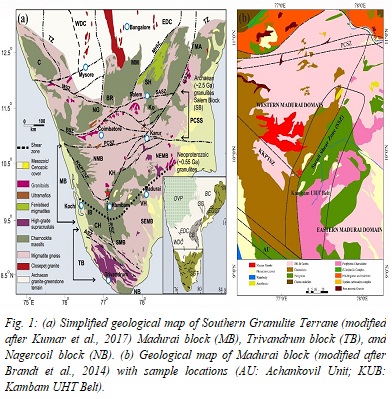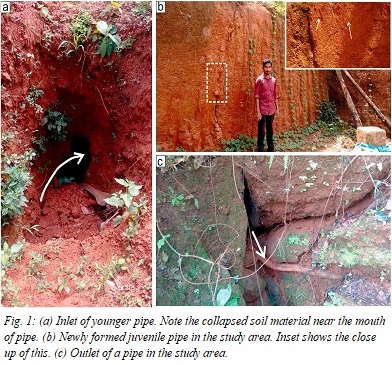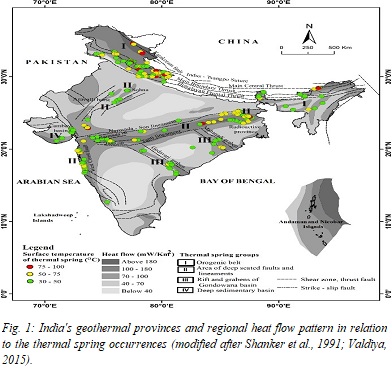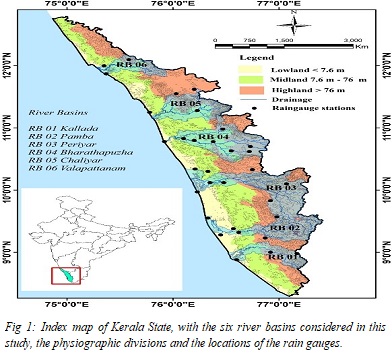Research Updates
 The Madurai block which forms the central crustal block in the Precambrian Southern Granulite Terrane, south India preserves crustal evolution history with record of multiple magmatic and metamorphic episodes ranging from early Archaean to late Neoproterozoic. Documenting the precise chronology and tectonothermal evolution of these events are of paramount importance to correlate with other crustal blocks in Southern Granulite Terrane as well as to link with other continental fragments of East Gondwana. The present study focuses on hitherto unreported location within a key section of Madurai block along the transcrustal Suruli shear zone known as the Kambam ultrahigh-temperature belt. This belt is noticeable for the proliferous occurrence of HT-UHT metapelites with an overall clockwise P-T trajectory. Samples of garnet-spinel granulite, cordierite-spinel granulite and associated granite gneiss were subjected to detailed petrographic, thermobarometric and geochronologic analysis. Combined petrography, mineral reaction, geothermobarometry and pseudosection modelling of the granulite samples reveal HT-UHT metamorphic conditions with clockwise P-T path demonstrating significant decompression and cooling. LA-ICPMS U-Pb dating of zircon, monazite and rutile phases within these samples constrain the timing of metamorphism as well as cooling. U-Pb zircon ages of ~2500 Ma from the granulites points to new evidences for Paleoproterozoic high-grade metamorphism in the area where monazite U-Pb ages at ~593 and ~557 Ma throw light into the imprints on ~36 Ma prolonged Neoproterozoic thermal event attributed to Pan African collisional orogeny. LA-MC-ICPMS Hf isotopic record from zircon cores point to the role of significant juvenile crustal melting/anatexis during Paleoproterozoic. In addition, several cryptic metamorphic pulses are also identified evincing the polydeformed evolutionary history of these rocks. The ca. ~432 Ma cooling age record from rutile estimates an average cooling rate of ~3.0 °C/Ma over a time period of ~125 Ma, classifying Madurai block as a classic slow cooled granulite terrane with long lived UHT orogenic history. The results also bring to the fore the importance of Kambam ultrahigh-temperature belt and Suruli shear zone which can be projected as a major terrane boundary within the Southern Granulite Terrane.
The Madurai block which forms the central crustal block in the Precambrian Southern Granulite Terrane, south India preserves crustal evolution history with record of multiple magmatic and metamorphic episodes ranging from early Archaean to late Neoproterozoic. Documenting the precise chronology and tectonothermal evolution of these events are of paramount importance to correlate with other crustal blocks in Southern Granulite Terrane as well as to link with other continental fragments of East Gondwana. The present study focuses on hitherto unreported location within a key section of Madurai block along the transcrustal Suruli shear zone known as the Kambam ultrahigh-temperature belt. This belt is noticeable for the proliferous occurrence of HT-UHT metapelites with an overall clockwise P-T trajectory. Samples of garnet-spinel granulite, cordierite-spinel granulite and associated granite gneiss were subjected to detailed petrographic, thermobarometric and geochronologic analysis. Combined petrography, mineral reaction, geothermobarometry and pseudosection modelling of the granulite samples reveal HT-UHT metamorphic conditions with clockwise P-T path demonstrating significant decompression and cooling. LA-ICPMS U-Pb dating of zircon, monazite and rutile phases within these samples constrain the timing of metamorphism as well as cooling. U-Pb zircon ages of ~2500 Ma from the granulites points to new evidences for Paleoproterozoic high-grade metamorphism in the area where monazite U-Pb ages at ~593 and ~557 Ma throw light into the imprints on ~36 Ma prolonged Neoproterozoic thermal event attributed to Pan African collisional orogeny. LA-MC-ICPMS Hf isotopic record from zircon cores point to the role of significant juvenile crustal melting/anatexis during Paleoproterozoic. In addition, several cryptic metamorphic pulses are also identified evincing the polydeformed evolutionary history of these rocks. The ca. ~432 Ma cooling age record from rutile estimates an average cooling rate of ~3.0 °C/Ma over a time period of ~125 Ma, classifying Madurai block as a classic slow cooled granulite terrane with long lived UHT orogenic history. The results also bring to the fore the importance of Kambam ultrahigh-temperature belt and Suruli shear zone which can be projected as a major terrane boundary within the Southern Granulite Terrane.
Bibliographic Info: Amal Dev, J., Tomson, J. K., Nilanjana Sorcar, Nandakumar, V. [2021]. Combined U-Pb/Hf isotopic studies and phase equilibrium modelling of HT-UHT metapelites from Kambam ultrahigh-temperature belt, South India: Constraints on tectonothermal history of the terrane. Lithos, Vol. 406-407, Art. 106531. https://doi.org/10.1016/j.lithos.2021.106531
 Every year, during the monsoon period (June–September), series of land subsidence incidences are reported from the Southern Western Ghats in India. These land subsidences occur primarily due to subsurface erosion, which leads to formation of soil pipes. These soil pipes are geo-morphologically an outcome of land degradation process that significantly influences the hill slope hydrology which makes the slopes vulnerable, and affects the human lives as well. However, detection of these subsurface pipes remains a serious challenge. Most of the previous studies are based on surface investigations, without considering the subsurface features. The present study aims to provide a more detailed account of these less-studied geomorphic features (soil pipes) using an integrated approach. The main purposes of the present study are to 1) describe the characteristic of the soil pipes and 2) to quantify the scale of piping activity; based on both surface and subsurface investigations in watershed scale. The remote sensing and GIS platform were used to delineate watershed boundary, identify geo morphological setup of the terrain, detailed landuse information and to bring out change in landuse, landcover pattern. The geomorphic mapping was carried out to identify the type of pipes, location of its inlet, outlet and other subsequent deformation features. The resistivity survey was done to map geometry of the pipe, piping network, subsurface lithology, and get the water table depth. The resistivity survey results indicate that the density of pipes are more than the estimated through surface mapping. Similarly, the length of the pipes is more than the mapped pipe through the surface mapping. The combined results suggest that the region is rich in these kinds of pipe features and may create hazard to the society residing in those areas. This study further underlined the importance of detailed study about soil piping phenomena to minimize its threat to human habitation and to provide specific recommendations to prevent the recurrence.
Every year, during the monsoon period (June–September), series of land subsidence incidences are reported from the Southern Western Ghats in India. These land subsidences occur primarily due to subsurface erosion, which leads to formation of soil pipes. These soil pipes are geo-morphologically an outcome of land degradation process that significantly influences the hill slope hydrology which makes the slopes vulnerable, and affects the human lives as well. However, detection of these subsurface pipes remains a serious challenge. Most of the previous studies are based on surface investigations, without considering the subsurface features. The present study aims to provide a more detailed account of these less-studied geomorphic features (soil pipes) using an integrated approach. The main purposes of the present study are to 1) describe the characteristic of the soil pipes and 2) to quantify the scale of piping activity; based on both surface and subsurface investigations in watershed scale. The remote sensing and GIS platform were used to delineate watershed boundary, identify geo morphological setup of the terrain, detailed landuse information and to bring out change in landuse, landcover pattern. The geomorphic mapping was carried out to identify the type of pipes, location of its inlet, outlet and other subsequent deformation features. The resistivity survey was done to map geometry of the pipe, piping network, subsurface lithology, and get the water table depth. The resistivity survey results indicate that the density of pipes are more than the estimated through surface mapping. Similarly, the length of the pipes is more than the mapped pipe through the surface mapping. The combined results suggest that the region is rich in these kinds of pipe features and may create hazard to the society residing in those areas. This study further underlined the importance of detailed study about soil piping phenomena to minimize its threat to human habitation and to provide specific recommendations to prevent the recurrence.
Bibliographic Info: Mayank Joshi, Prasobh, P. R., Rajappan, S., Padma Rao, B., Alka Gond, Anshuman Misra, Eldhose, K., Nandakumar, V., Tomson, J. K. [2021]. Detection of soil pipes through remote sensing and electrical resistivity method: Insight from southern Western Ghats, India. Quaternary International, Vol. 575-576, pp. 51-61. https://doi.org/10.1016/j.quaint.2020.08.021
 The widely distributed thermal springs in India are reviewed from a hydrogeochemical and isotopic perspective. Based on the geotectonic framework, the thermal springs are classified into four groups: (a) Orogenic belt, (b) Areas of deep-seated faults and lineaments, (c) Rifts and grabens of Gondwana basin and (d) Deep sedimentary basin. Detailed investigations over the last few decades culminated in the development of a vast geochemical database for thermal springs and associated gaseous phases, which are now available online since the late 1960s. After a careful evaluation of their quality and reliability, these data have been used in this study. Representative datasets of thermal spring waters from each group and subgroup have been evaluated following a classical approach, including water classifications, use of the triangular diagrams, geothermometric estimates and isotopic signatures that identified significant hydrogeochemical variations among different thermal spring clusters. Differences in rock-water interactions, and system characteristics such as water source, heat source, and topographic relief, were found to be the causes of observed variations. Thermal springs near the coast of western India have a high Cl content relative to Na, indicating that they have been influenced by seawater. Most thermal springs in the northern territory have high HCO3 and low Cl, suggesting that they have mixed with HCO3-rich near-surface water. Due to their emergence from the Precambrian crystallines, most thermal springs in the central and eastern part of India are distributed within the Na-Cl and Na-Cl-HCO3 type facies with low SO4 content. Different geochemical thermometers such as silica, cation thermometers, and a combination of silica K-Mg systems were used to estimate reservoir temperatures, resulting in a temperature range of roughly 60–140°C. Because of the lack of equilibrium, the values of reservoir temperatures between 200°C and 300°C obtained using Na-K geothermometers may not be reliable. In general, the reservoir temperatures for thermal springs in India's northern and eastern parts are greater than those located in the southern and western continental margins. The chemistry of the associated gaseous discharges is dominated by atmospheric components. The exceptions are thermal springs from the Orogenic belt of Himalaya that are enriched with CO2 possibly sourced from metamorphic decarbonation. The 3He/4He isotopic ratio in the gaseous discharge across all the groups and subgroups predominantly bears signatures of crustal origin. Stable isotopic signatures strongly suggest that these hydrothermal systems are predominantly recharged by local meteoric waters. In contrast, a discernible positive oxygen-isotopic shift in thermal waters indicates the existence of high enthalpy reservoirs in the NW Himalayan region. With the exception of a few springs, long circulation time (>50 years) of meteoric waters within the conduit is indicated by low tritium values in the thermal waters.
The widely distributed thermal springs in India are reviewed from a hydrogeochemical and isotopic perspective. Based on the geotectonic framework, the thermal springs are classified into four groups: (a) Orogenic belt, (b) Areas of deep-seated faults and lineaments, (c) Rifts and grabens of Gondwana basin and (d) Deep sedimentary basin. Detailed investigations over the last few decades culminated in the development of a vast geochemical database for thermal springs and associated gaseous phases, which are now available online since the late 1960s. After a careful evaluation of their quality and reliability, these data have been used in this study. Representative datasets of thermal spring waters from each group and subgroup have been evaluated following a classical approach, including water classifications, use of the triangular diagrams, geothermometric estimates and isotopic signatures that identified significant hydrogeochemical variations among different thermal spring clusters. Differences in rock-water interactions, and system characteristics such as water source, heat source, and topographic relief, were found to be the causes of observed variations. Thermal springs near the coast of western India have a high Cl content relative to Na, indicating that they have been influenced by seawater. Most thermal springs in the northern territory have high HCO3 and low Cl, suggesting that they have mixed with HCO3-rich near-surface water. Due to their emergence from the Precambrian crystallines, most thermal springs in the central and eastern part of India are distributed within the Na-Cl and Na-Cl-HCO3 type facies with low SO4 content. Different geochemical thermometers such as silica, cation thermometers, and a combination of silica K-Mg systems were used to estimate reservoir temperatures, resulting in a temperature range of roughly 60–140°C. Because of the lack of equilibrium, the values of reservoir temperatures between 200°C and 300°C obtained using Na-K geothermometers may not be reliable. In general, the reservoir temperatures for thermal springs in India's northern and eastern parts are greater than those located in the southern and western continental margins. The chemistry of the associated gaseous discharges is dominated by atmospheric components. The exceptions are thermal springs from the Orogenic belt of Himalaya that are enriched with CO2 possibly sourced from metamorphic decarbonation. The 3He/4He isotopic ratio in the gaseous discharge across all the groups and subgroups predominantly bears signatures of crustal origin. Stable isotopic signatures strongly suggest that these hydrothermal systems are predominantly recharged by local meteoric waters. In contrast, a discernible positive oxygen-isotopic shift in thermal waters indicates the existence of high enthalpy reservoirs in the NW Himalayan region. With the exception of a few springs, long circulation time (>50 years) of meteoric waters within the conduit is indicated by low tritium values in the thermal waters.
Bibliographic Info: Prasenjit Das, Maya, K., Padmalal, D. [2021]. Hydrogeochemistry of the Indian thermal springs: Current status. Earth-Science Reviews, Vol. 224, Art. 103890. https://doi.org/10.1016/j.earscirev.2021.103890
 A better understanding of the trends in rainfall, its distribution and characteristics is of paramount importance, for effective management of water resources, especially, in regions with marked spatiotemporal variability in rainfall. The present study examines the spatiotemporal changes in rainfall pattern and its effect on the hydrological regime of a tropical monsoon dominated region in Western Ghats, India. Weakening of monsoon rains was observed in the region, with decreasing trend in monsoon season, increasing trend in pre-monsoon season as well as an accelerated change in rainfall pattern during the recent decades. Monsoon droughts are becoming more prominent as evidenced the increasing trend in total number of dry and prolonged dry spells. Seasonality Index of rainfall consistently showed decreasing trend indicating that the rainfall distribution is becoming more symmetric over the years. No significant relationship was observed between ENSO events and rainfall characteristics indicating that ENSO episodes do not considerably affect the variability of rainfall in the region. Effect of changes in rainfall characteristics have a strong bearing on the hydrological regime of the region, which was evident in the declining trend of streamflow and groundwater level. The study calls for a revised plan for water management, adaptive cropping pattern and reservoir operations in the state of Kerala.
A better understanding of the trends in rainfall, its distribution and characteristics is of paramount importance, for effective management of water resources, especially, in regions with marked spatiotemporal variability in rainfall. The present study examines the spatiotemporal changes in rainfall pattern and its effect on the hydrological regime of a tropical monsoon dominated region in Western Ghats, India. Weakening of monsoon rains was observed in the region, with decreasing trend in monsoon season, increasing trend in pre-monsoon season as well as an accelerated change in rainfall pattern during the recent decades. Monsoon droughts are becoming more prominent as evidenced the increasing trend in total number of dry and prolonged dry spells. Seasonality Index of rainfall consistently showed decreasing trend indicating that the rainfall distribution is becoming more symmetric over the years. No significant relationship was observed between ENSO events and rainfall characteristics indicating that ENSO episodes do not considerably affect the variability of rainfall in the region. Effect of changes in rainfall characteristics have a strong bearing on the hydrological regime of the region, which was evident in the declining trend of streamflow and groundwater level. The study calls for a revised plan for water management, adaptive cropping pattern and reservoir operations in the state of Kerala.
Bibliographic Info: Merin Mariam Mathew, Sreelash, K., Micky Mathew, Arulbalaji, P., Padmalal, D. [2021]. Spatiotemporal variability of rainfall and its effect on hydrological regime in a tropical monsoon-dominated domain of Western Ghats, India. Journal of Hydrology: Regional Studies, Vol. 36, Art. 100861. https://doi.org/10.1016/j.ejrh.2021.100861
This research incorporates iron-loaded crosslinked chitosan (CS) polymeric structure into the interlayer lattice space of Montmorillonite clay (MT) to enhance the phosphate adsorption capacity of MT. The synthesized Fe-loaded crosslinked chitosan montmorillonite composite (Fe-CS-MT) is evaluated effectively for phosphate removal from aqueous media. Batch adsorption experiments optimized the influence of adsorption parameters, i.e., contact time (50 min), solution pH (3), and adsorbent dosage (2 g L−1) for phosphate removal. The experimental results of equilibrium and kinetic studies indicated that phosphate adsorption on Fe-CS-MT follows Pseudo-second-order kinetic and Freundlich isotherm models with a high degree of accuracy. A series of analytical tools used to profile the investigated material's surface features involves CHNS Analyser, SEM-EDX, FTIR, XRD, XRF, UV-Visible Spectrophotometer, TGA, DSC, and surface analysis. The calculations of the thermodynamic study confirmed the endothermic and spontaneous nature of the phosphate adsorption process. This study presents an eco-friendly adsorbent tested in natural conditions to assess the feasibility of removing phosphate from an aqueous phase.
Bibliographic Info: Sandhya Sudhakaran, Elezabeth, V. A., Harsha Mahadevan, Anoop Krishnan, K. [2021]. Crosslinked chitosan-montmorillonite biocomposite with Fe intercalation: Enhancing surface chemistry for improved phosphate adsorption. Surfaces and Interfaces, Vol. 27, Art. 101468. https://doi.org/10.1016/j.surfin.2021.101468




 RTI Act
RTI Act

